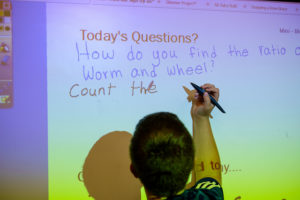Assessment isn’t bad. Whew! I got that off my chest. And before you take a breath to agree or disagree, let me explain why I threw that out there. My recent thumbing through various social media platforms proves that assessment is THE hot topic in the current education debate. From YouTube videos to #TwitterChats to Pinterest cartoons, taking a stance on assessment is all the rage. So we should argue whether “to test or not to test?” No, that is not the issue. How about focusing on how often we test? No, that is still not the issue.
As an educator who has worked both in and out of the classroom, I now understand that what really matters is WHY we test. Assessment should be a subtle, ongoing process used to measure teacher efficacy and student skill level. It is a process that will yield information that directs students and teachers to the next level of learning. And the best part? Assessment should be a learning tool. Students should glean new information from an assessment while still demonstrating what they currently can do.
 Notice that I said “what they CAN DO.” I did not say that an assessment should measure what they KNOW. Our paradigm shift in education is that we should be teaching skills over content. Standards such as the Common Core State Standards focus on what students should know how to do to be college and career ready. This knowledge does not amount to a list of dates or definitions or pieces of information to store for later. And, if we are going to teach skill-based instruction, then we also need skill-based assessments. This sounds easy but is incredibly complex.
Notice that I said “what they CAN DO.” I did not say that an assessment should measure what they KNOW. Our paradigm shift in education is that we should be teaching skills over content. Standards such as the Common Core State Standards focus on what students should know how to do to be college and career ready. This knowledge does not amount to a list of dates or definitions or pieces of information to store for later. And, if we are going to teach skill-based instruction, then we also need skill-based assessments. This sounds easy but is incredibly complex.
From my vantage point as an instructional coach, I see multiple classrooms in multiple schools across multiple districts. This is the complexity of assessment. For any assessment (formal or informal) to be valid and beneficial, it has to align to what I, as a teacher, expect the outcome to be as well as what the curriculum provides. This alignment must be based on what my students’ levels and needs are but also on the standards to be taught. More importantly, assessment should mirror the real-world expectations of what students will need to be able to do in a job setting or a college classroom. This is authenticity.
In addition to being authentic, assessment should be subtle. Students can become anxious over the word assessment because they automatically relate the term to a visible paper or screen with a set of questions on which they are going to be judged. It is like a mandatory audition for American Idol and they aren’t sure if they’ve practiced the right song.
I observed a great example of aligned, subtle assessment in one of our alternative schools, and I was excited because this was the same way I had used assessment for years. The teacher divided the class into two teams; a student then came to the front, selected a random number, and worked out a practical science question. A correct answer allowed students to earn extra points by making a free throw in the basket. An incorrect answer had to be reworked by the class. The students were EAGER to get to the front and, of course, shoot baskets. The teacher explained afterwards that he used questions similar to the end-of-the-year assessment using the current standards they were working on mastering. This sounds an awful lot like assessment to me. He knew what topics needed to be revisited and which students needed extra support. Yet, the students had no clue that they just took a “test.”
The purpose of assessment is not only to measure learning but also to initiate learning and it therefore must be ongoing and embedded. State assessments are positive only if they are not being used for the sake of testing but are instead subtly integrated into daily practice and do not mirror the expectations of the end of year tests. In a recent op-ed, Secretary of Education Arne Duncan wrote, “To measure student progress in a useful way, states need an annual statewide assessment. But the tests — and test preparation — must not take excessive time away from classroom instruction. Great teaching, not test prep, is what engages students and leads to higher achievement.” Mr. Duncan was almost right. Great teaching IS test prep, because we are assessing students continually on the skills that are necessary for college and career. These, of course, are the ultimate tests.
Teaching must be grounded in assessment and assessment must be grounded in teaching. If local districts and states give teachers the power to infuse assessment into instruction, then we do not have to spend time away from class on “official” assessments created by outside companies, or on the required interim tests. The “one right one” at the end is enough!
